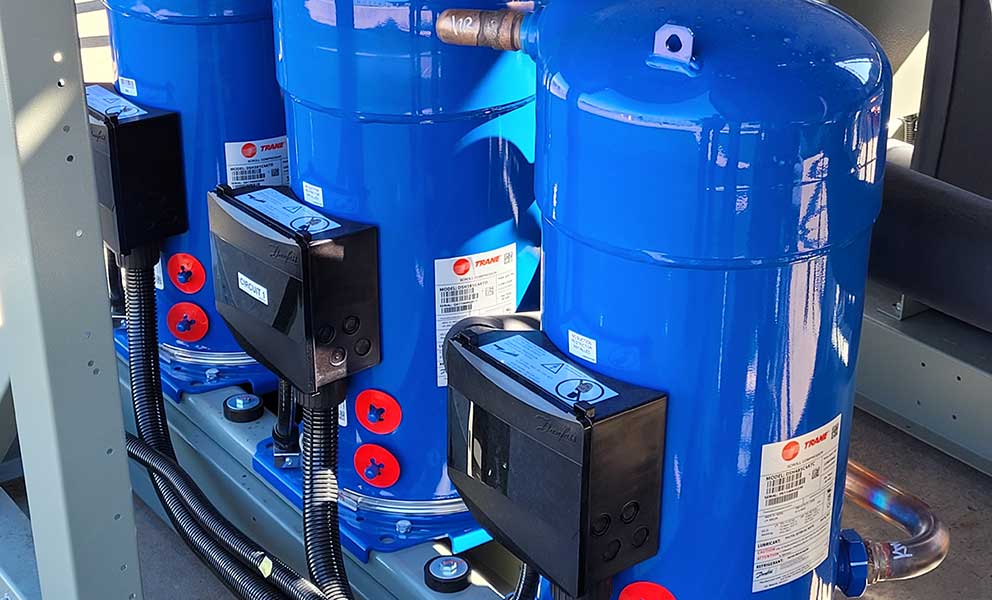High-tech manufacturing that creates components used in the clean energy market is booming. Fueled by increased consumer demand as well as an influx of government funding, manufacturers of products like EV batteries and semiconductors are growing rapidly. The EV market, for example, is growing at an estimated 23.1% CAGR from 2023 to 2032, and the semiconductor industry is expected to grow its revenue by 80% by 2030.
This has led to new plants being built at a rapid pace and while these businesses have built their product lines to create clean and sustainable products, the reality is the manufacturing plants themselves are often powered by fossil fuels, leading to high Scope 1 emissions.
If you’re a high-tech manufacturer you likely have audacious corporate sustainability goals that you need to meet. Your entire company is built on the premise of helping create a greener planet and you’re pioneering the ways we rethink our technology, our transportation, and our lives. But your operational emissions might not match those audacious goals – yet. The experts at Trane are here to help make those goals a reality, with proven steps to decarbonize operations.
Why is Decarbonization for High-Tech Manufacturers So Difficult?
The operational requirements to run these high-tech manufacturing facilities are complex. Often requiring very specific temperatures to maintain product integrity, simply swapping out heating and cooling equipment to be more energy-efficient isn’t an option. The truth is, because of the complex nature of the business, many of these businesses don’t even have a realistic grasp on their current energy consumption. This has led to a disconnect between corporate goals and operational realities. There is a desire to decarbonize operations, but the nuance required to operate these facilities makes creating a clear decarbonization plan difficult. There isn’t a one-size-fits-all decarbonization road map to follow. Decarbonization plans need to be customized to the specific nuances of each business and should be action-oriented with a long-term vision in mind.
The good news is that creating a realistic decarbonization plan is possible and the experts at Trane want to be with you to help you through it each step of the way.
5 Ways to decarbonize high-tech manufacturing facilities
Tip #1: Forge a consultative partnership with experts
First and foremost, the most common mistake we see high-tech manufacturers make is trying to figure it out on their own. In these instances, we often see businesses over-emphasize the importance of Scope 3 emission reduction. This makes sense given that the purpose of their entire product line is to create a more sustainable planet, but the reality is you cannot fully decarbonize relying on Scope 3 emissions alone.
An energy services partner can help by first understanding current systems and emissions, and then creating a long-term plan to reduce emissions. We can help you understand the realities of what can be achieved using products on the market today, while also ensuring you’re first in line as new products hit the market.
Tip #2: Build energy efficiency into your operations
The easiest and most common place to start on a decarbonization journey is to increase energy efficiency. Through monitoring controls, automation, and consumption management, you can ensure that each facility you operate is running as efficiently as possible without needing to replace a single piece of equipment.
Tip #3: Electrify where possible
We know that using heat pumps to electrify operations is a primary path to net-zero emissions.
But the truth is that full plant electrification is not yet possible for many high-tech manufacturing facilities. The nuanced heating and cooling requirements of the products being made mean that current heat pumps on the market don’t get hot enough for some aspects of the manufacturing process. But that doesn’t mean that you can’t incorporate some electrification into your facilities. Using heat pumps for chilled water requirements, for example, is a great way to reduce some of your operational emissions. What’s better, as new heat pumps are created that can power the higher-temperature areas of your facilities, you’ll be well set up to make the switch.
Tip #4: Use heat recovery to bridge the gap until full electrification
Heat recovery is the process of recovering what would be wasted energy and diverting it to power another area of the facility. It makes sure you are getting the most out of the energy you are currently using. Using a heat recovery chiller, manufacturers can capture heat that is produced to make chilled water and reuse it to heat the other side of the building. This saves energy and cuts down on costs.
Tip #5: Capitalize on federal funding
The U.S. government is committed to investing in American manufacturing and the development of leading-edge technologies that create a more sustainable future. From The CHIPS and Science Act to The Inflation Reduction Act, there is a lot of funding on the table that can be used for decarbonization projects. Trane® has decades of experience helping companies take advantage of federal funding. We can partner with your team to ensure you understand what funding options are available and help you get your cut of the funding.
For high-tech manufacturers working in the EV battery, semiconductor, or microchip space, decarbonization is a long-term initiative. But starting now will put you on the right path to meet customer expectations and audacious corporate goals. By partnering with an energy services company, you can create a comprehensive plan that takes advantage of products currently on the market and puts you first in line as new innovations become available. Contact the Trane® team to get started on your decarbonization journey today.
Trane High Tech Solutions

Actively managing the refrigerants used in your facilities can play an important role in decarbonization. As the healthcare industry works to help lower its carbon footprint, your healthcare operations likely have a sustainability goal that facilities are expected to meet.

Trane is committed to helping customers transition to next-generation, low-GWP refrigerants, ensuring the right solution for each application. With insights from Steve Kujak, Trane's Director of Next Generation Refrigerant Research, we explore the role of refrigerants in decarbonization and the benefits of A2L refrigerants.
-
Blog
-
Decarbonization
-
 Decarbonizing Healthcare: Why Refrigerant Management is the Next Big Step
Decarbonizing Healthcare: Why Refrigerant Management is the Next Big StepActively managing the refrigerants used in your facilities can play an important role in decarbonization. As the healthcare industry works to help lower its carbon footprint, your healthcare operations likely have a sustainability goal that facilities are expected to meet.
-
 Understanding A2L Refrigerants: A Q&A with Steve Kujak
Understanding A2L Refrigerants: A Q&A with Steve KujakTrane is committed to helping customers transition to next-generation, low-GWP refrigerants, ensuring the right solution for each application. With insights from Steve Kujak, Trane's Director of Next Generation Refrigerant Research, we explore the role of refrigerants in decarbonization and the benefits of A2L refrigerants.
-
 Building a Proactive Healthcare Decarbonization Strategy
Building a Proactive Healthcare Decarbonization StrategyDecarbonization is essential for reducing carbon footprints, cutting costs, and minimizing environmental impact in healthcare facilities. Trane helps you achieve this through energy efficiency, electrification, eco-friendly refrigerants, and renewable energy solutions.
































































































